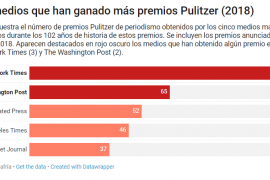
On October 28th at 3 o'clock a.m. we rewinded the...

The two artists embrace each other in a joint exhibition...
In its fourth edition, the Audiovisual Talent Week, maintains the...

CosmoCaixa commemorates the half century of the arrival to the...

The direct relationship between intelligence and success applies to any...

Research data confirm that physical exercise inactivity is a serious...

Since the Walkman we have walked from one place to...

Lung cancer with tumors that present a specific epigenetic mark,...

Why have the Real Estate Market Listed Public Limited Companies—the...

The New York Times, with a total of 125 awards,...

Música clásica sobre la arena de la playa en dos...

The first session of the cycle on the regatta organized...

The hospital's managing director, Manel del Castillo, and the pharmaceutical...

Generalitat y Ayuntamiento impulsarán dos equipamientos de 'Casa de les...

Leticia Beleta, director of Alexion Pharmaceuticals in Spain and Portugal,...

We all have a friend who never leaves the Gràcia...

Barcelona director opts for Best International Film with 'La sociedad...

The hotel and industrial sectors softened the market's decline last...

The technology company, with a workforce of 35 employees and...

“The women of yesteryear were strong and had to fight...

The American sociologist James Coleman was the first to note, during the 1950s, the emergence of adolescence as a new cultural group between childhood and the adult world. Teenagers had always existed, but teenage culture was a new phenomenon. Its appearance was enabled by the universalization of education and the subsequent transfer of responsibility from families to schools. It had been conceived as the great lever of social change, because it would enable a universal education for all young people and thus help families overcome cultural limits. However, Coleman noted that teenagers were more interested in their popularity than their intellectual training.
Schools were created to ease the process of maturing from child to citizen, but school children lived immersed in a culture that was partially closed in itself, reluctant to adult models, while uncritically accepting their own generational models. The new “teenager society” was culturally independent. They had their own language, fashion, music, their own ways of communicating and behavioural models, which were often defined in opposition to those of their parents. And all this was reinforced by advertising, because teenage culture was giving rise to a new market with great consumer potential.
TEENAGERS IN THEIR THIRTIES. “We live,” Coleman wrote in 1959, “in a peculiar paradox: in our complex industrial society there are more and more things to learn, and formal education is increasingly important to open up life opportunities; but we’ve created a great culture of teenagers who show little interest in education while feeling subjugated by things that have little to do with school.” It’s obvious that Coleman didn’t have the final word on adolescence. Today we are witnessing an expansion of its borders. At the lower end, it seems to have engulfed puberty and, at the top end, we’ve all seen teenagers in their –let’s be nice– thirties. Ten-year-old girls want sexy clothes and thirty-year-old guys, teenage clothes. Children want to anticipate their teenage years and teenagers to postpone their adult life. 25% of viewers of children’s television channels in the United States are adults.
Today teenagers from the 50s seem pretty naive. 70% didn’t smoke and 80% didn’t drink. It didn’t occur to Coleman to ask them if they took drugs or had safe sex. According to a study by the Public Health Agency of Barcelona, about 47% of girls and 43% of boys who are sixteen years old admit to having been drunk at least once in the last year. The average age for children to start drinking is now 13.7. The average teenager has twice as much money today –in real terms– as one in Coleman’s time. There are girls that start dreaming of plastic surgery when they hit puberty.
As society has become more complex, the gap between the spontaneous interests of children and the knowledge demands of the adult world has been widening, but because at the same time, we increasingly praise spontaneity, we start to fear that teenagers become the behavioural model in our societies. Can we not see that psychological traits that were considered typically restricted to teenagers such as confusion, constant hesitation, unpredictable mood swings, discomfort with one’s looks, etc., have now spread to other age groups?

WITHOUT FACING THE FUTURE. Our teenagers live in a world in which a sense of possibility is in constant growth at the expense of a sense of reality. It can’t be any other way because they are opposing forces. That phrase “Be realistic, ask for the impossible” is not a slogan anymore, but a prejudice. If formerly teenagers were made to live certain rituals of passage to become adults, now we don’t really know if we have a well-defined adult life to offer them. In fact, what we are continually recommending them to do is to not conform, to be adaptable. In schools, they are told that knowing things is less important than knowing how to work things. If traditionally, knowledge was the intellectual way of looking after the soul for its ability to provide experiences of order, today we encourage living with the disorder of the ephemeral.
Our advice to teenagers is: “Be water, my friend”, be amorphous, don’t let limits restrain you, be adaptable
Surprisingly, a society that has made autonomy and critical sense the axes of today’s secular religion, is able to reconcile itself with millstones and accepts that the only thing we know about the future is its lack of definition as an indisputable dogma and thus that we must prepare new generations to cope and adapt to an ever-changing future, since, as we incessantly repeat, they will work in activities that have not yet been invented with tools that we have not yet designed, solving problems that we still don’t have.
The first to say this was a Labour pedagogue, Peter Mauger in 1966, so, 51 years ago. “The adults of tomorrow,” he said, “will face problems of a nature we can’t even imagine today. They’ll have to do jobs we haven’t invented yet.” The idea was picked up by Bill Clinton, in 1996, and his education secretary, Richard Riley, in 2004: “The jobs that will be most in demand in 2010, don’t exist yet. The workers of the immediate future will use a technology we haven’t invented yet to solve problems that we don’t even suspect today will be problems tomorrow.” I could quote hundreds of similar statements uttered in the most serious environments by allegedly competent people. I’ll only add the warning from the World Economic Forum in Davos last year, which in its report: The Future of Jobs, insisted that “65% of the children who start primary school today will end up working in entirely new jobs, which still don’t exist.“
In short, our advice to teenagers is: “Be water, my friend”, be amorphous, don’t let limits restrain you, be adaptable. But we are the adults Mauger, Clinton and Riley were referring to and some of us are already retired. So if we want to know what the skills of the future will be, we need to learn from today’s most competent people, those who are already solving new problems successfully, with new tools. In them, we’ll find the following characteristics: 1. Control of attention, which will possibly be the new type of IQ. 2. A consistent education that enables them to be skilful. 3. The ability to build trust and stay true to their word. 4. The ability to introduce a reflection period between the appearance of a desire and a response, in order to organize action. This is what we call strategic thinking. I usually defend the child’s right to be frustrated, thinking about the right of a pastry chef to not eat the ingredients while making a cake. 5. Willingness to not just be modern, that is, to have a broad perspective on the present that goes beyond the immediate. Without realizing it, we have witnessed a profound mutation of the meaning of “modern”. Modernity no longer refers to a chronological point in the universal time line, but to a position in the scale of values. Modernity has been axiologically infused, to the point that no one gets upset if you tell them they’re wrong, but you better not call someone out-dated. The modern person doesn’t feel part of a tradition, but lives fascinated by the continuous imminence of the new, convinced that being is being improvable. What increases someone’s value today is their acquisition of the latest anthropological prosthesis –the latest technological apparatus– that increases their awareness of what is possible.
“JUST GOOGLE IT”. What we call “21st century skills” is an illusion. Neither knowledge, memory nor the old intellectual virtues have lost their worth. What has been devalued is gross information, but rigorously filtered information has been revalued. “Just Google It” is a fallacy, as is promoting creativity without knowledge. The first thing you need do in order to solve a problem creatively is know the problem well. Precisely because the new doesn’t stop growing, it is essential to have a good knowledge base to integrate novelty into a narrative. I don’t know anyone who doesn’t want to have a better memory, or anyone who’s well informed about the importance of long-term memory take forgetfulness lightly. Were creativity, innovation, critical thinking irrelevant in the past? Isn’t it ridiculous to want to learn rigorously without studying hard? Can one think well without intellectual discipline? Perhaps one of the best kept secrets of the adult world is that, in reality, there are few adults although there are many who appear to be so. But we can’t just abandon teenagers to their fate by telling them that at their age we were doing the same things as them, because we shouldn’t be offering them models of teenage life, but of adult life, which is the life we all have to build.

The American sociologist James Coleman was the first to note, during the 1950s, the emergence of adolescence as a new cultural group between childhood and the adult world. Teenagers had always existed, but teenage culture was a new phenomenon. Its appearance was enabled by the universalization of education and the subsequent transfer of responsibility from families to schools. It had been conceived as the great lever of social change, because it would enable a universal education for all young people and thus help families overcome cultural limits. However, Coleman noted that teenagers were more interested in their popularity than their intellectual training.
Schools were created to ease the process of maturing from child to citizen, but school children lived immersed in a culture that was partially closed in itself, reluctant to adult models, while uncritically accepting their own generational models. The new “teenager society” was culturally independent. They had their own language, fashion, music, their own ways of communicating and behavioural models, which were often defined in opposition to those of their parents. And all this was reinforced by advertising, because teenage culture was giving rise to a new market with great consumer potential.
TEENAGERS IN THEIR THIRTIES. “We live,” Coleman wrote in 1959, “in a peculiar paradox: in our complex industrial society there are more and more things to learn, and formal education is increasingly important to open up life opportunities; but we’ve created a great culture of teenagers who show little interest in education while feeling subjugated by things that have little to do with school.” It’s obvious that Coleman didn’t have the final word on adolescence. Today we are witnessing an expansion of its borders. At the lower end, it seems to have engulfed puberty and, at the top end, we’ve all seen teenagers in their –let’s be nice– thirties. Ten-year-old girls want sexy clothes and thirty-year-old guys, teenage clothes. Children want to anticipate their teenage years and teenagers to postpone their adult life. 25% of viewers of children’s television channels in the United States are adults.
Today teenagers from the 50s seem pretty naive. 70% didn’t smoke and 80% didn’t drink. It didn’t occur to Coleman to ask them if they took drugs or had safe sex. According to a study by the Public Health Agency of Barcelona, about 47% of girls and 43% of boys who are sixteen years old admit to having been drunk at least once in the last year. The average age for children to start drinking is now 13.7. The average teenager has twice as much money today –in real terms– as one in Coleman’s time. There are girls that start dreaming of plastic surgery when they hit puberty.
As society has become more complex, the gap between the spontaneous interests of children and the knowledge demands of the adult world has been widening, but because at the same time, we increasingly praise spontaneity, we start to fear that teenagers become the behavioural model in our societies. Can we not see that psychological traits that were considered typically restricted to teenagers such as confusion, constant hesitation, unpredictable mood swings, discomfort with one’s looks, etc., have now spread to other age groups?

WITHOUT FACING THE FUTURE. Our teenagers live in a world in which a sense of possibility is in constant growth at the expense of a sense of reality. It can’t be any other way because they are opposing forces. That phrase “Be realistic, ask for the impossible” is not a slogan anymore, but a prejudice. If formerly teenagers were made to live certain rituals of passage to become adults, now we don’t really know if we have a well-defined adult life to offer them. In fact, what we are continually recommending them to do is to not conform, to be adaptable. In schools, they are told that knowing things is less important than knowing how to work things. If traditionally, knowledge was the intellectual way of looking after the soul for its ability to provide experiences of order, today we encourage living with the disorder of the ephemeral.
Our advice to teenagers is: “Be water, my friend”, be amorphous, don’t let limits restrain you, be adaptable
Surprisingly, a society that has made autonomy and critical sense the axes of today’s secular religion, is able to reconcile itself with millstones and accepts that the only thing we know about the future is its lack of definition as an indisputable dogma and thus that we must prepare new generations to cope and adapt to an ever-changing future, since, as we incessantly repeat, they will work in activities that have not yet been invented with tools that we have not yet designed, solving problems that we still don’t have.
The first to say this was a Labour pedagogue, Peter Mauger in 1966, so, 51 years ago. “The adults of tomorrow,” he said, “will face problems of a nature we can’t even imagine today. They’ll have to do jobs we haven’t invented yet.” The idea was picked up by Bill Clinton, in 1996, and his education secretary, Richard Riley, in 2004: “The jobs that will be most in demand in 2010, don’t exist yet. The workers of the immediate future will use a technology we haven’t invented yet to solve problems that we don’t even suspect today will be problems tomorrow.” I could quote hundreds of similar statements uttered in the most serious environments by allegedly competent people. I’ll only add the warning from the World Economic Forum in Davos last year, which in its report: The Future of Jobs, insisted that “65% of the children who start primary school today will end up working in entirely new jobs, which still don’t exist.“
In short, our advice to teenagers is: “Be water, my friend”, be amorphous, don’t let limits restrain you, be adaptable. But we are the adults Mauger, Clinton and Riley were referring to and some of us are already retired. So if we want to know what the skills of the future will be, we need to learn from today’s most competent people, those who are already solving new problems successfully, with new tools. In them, we’ll find the following characteristics: 1. Control of attention, which will possibly be the new type of IQ. 2. A consistent education that enables them to be skilful. 3. The ability to build trust and stay true to their word. 4. The ability to introduce a reflection period between the appearance of a desire and a response, in order to organize action. This is what we call strategic thinking. I usually defend the child’s right to be frustrated, thinking about the right of a pastry chef to not eat the ingredients while making a cake. 5. Willingness to not just be modern, that is, to have a broad perspective on the present that goes beyond the immediate. Without realizing it, we have witnessed a profound mutation of the meaning of “modern”. Modernity no longer refers to a chronological point in the universal time line, but to a position in the scale of values. Modernity has been axiologically infused, to the point that no one gets upset if you tell them they’re wrong, but you better not call someone out-dated. The modern person doesn’t feel part of a tradition, but lives fascinated by the continuous imminence of the new, convinced that being is being improvable. What increases someone’s value today is their acquisition of the latest anthropological prosthesis –the latest technological apparatus– that increases their awareness of what is possible.
“JUST GOOGLE IT”. What we call “21st century skills” is an illusion. Neither knowledge, memory nor the old intellectual virtues have lost their worth. What has been devalued is gross information, but rigorously filtered information has been revalued. “Just Google It” is a fallacy, as is promoting creativity without knowledge. The first thing you need do in order to solve a problem creatively is know the problem well. Precisely because the new doesn’t stop growing, it is essential to have a good knowledge base to integrate novelty into a narrative. I don’t know anyone who doesn’t want to have a better memory, or anyone who’s well informed about the importance of long-term memory take forgetfulness lightly. Were creativity, innovation, critical thinking irrelevant in the past? Isn’t it ridiculous to want to learn rigorously without studying hard? Can one think well without intellectual discipline? Perhaps one of the best kept secrets of the adult world is that, in reality, there are few adults although there are many who appear to be so. But we can’t just abandon teenagers to their fate by telling them that at their age we were doing the same things as them, because we shouldn’t be offering them models of teenage life, but of adult life, which is the life we all have to build.
